 Gautama Buddha or Siddhārtha Gautama Buddha was a spiritual teacher from the Indian subcontinent, on whose teachings Buddhism was founded. The word Buddha is a title for the first awakened being in an era. In most Buddhist traditions, Siddhartha Gautama is regarded as the Supreme Buddha (P. sammāsambuddha, S. samyaksaṃbuddha) of our age, “Buddha” meaning “awakened one” or “the enlightened one.” Gautama Buddha may also be referred to as Śākyamuni. The Buddha found a Middle Way that ameliorated the extreme asceticism found in the Sramana religions.The time of Gautama’s birth and death are uncertain: most early 20th-century historians dated his lifetime as c. 563 BCE to 483 BCE, but more recent opinion dates his death to between 486 and 483 BCE or, according to some, between 411 and 400 BCE. UNESCO lists Lumbini, Nepal, as a world heritage site and birthplace of Gautama Buddha. There are also claims about birth place of Gautama Buddha to be Kapileswara, Orissa or Kapilavastu at Piprahwa, Uttar Pradesh He later taught throughout regions of eastern India such as Magadha and Kośala.
Gautama Buddha or Siddhārtha Gautama Buddha was a spiritual teacher from the Indian subcontinent, on whose teachings Buddhism was founded. The word Buddha is a title for the first awakened being in an era. In most Buddhist traditions, Siddhartha Gautama is regarded as the Supreme Buddha (P. sammāsambuddha, S. samyaksaṃbuddha) of our age, “Buddha” meaning “awakened one” or “the enlightened one.” Gautama Buddha may also be referred to as Śākyamuni. The Buddha found a Middle Way that ameliorated the extreme asceticism found in the Sramana religions.The time of Gautama’s birth and death are uncertain: most early 20th-century historians dated his lifetime as c. 563 BCE to 483 BCE, but more recent opinion dates his death to between 486 and 483 BCE or, according to some, between 411 and 400 BCE. UNESCO lists Lumbini, Nepal, as a world heritage site and birthplace of Gautama Buddha. There are also claims about birth place of Gautama Buddha to be Kapileswara, Orissa or Kapilavastu at Piprahwa, Uttar Pradesh He later taught throughout regions of eastern India such as Magadha and Kośala.
Gautama is the primary figure in Buddhism, and accounts of his life, discourses, and monastic rules are believed by Buddhists to have been summarized after his death and memorized by his followers. Various collections of teachings attributed to him were passed down by oral tradition, and first committed to writing about 400 years later.
Early life and marriage
Siddhartha was born in a royal Hindu Kshatriya family. He was brought up by his mother’s younger sister, Maha Pajapati. By tradition, he is said to have been destined by birth to the life of a prince, and had three palaces (for seasonal occupation) built for him. Although more recent scholarship doubts this status, his father, said to be King Śuddhodana, wishing for his son to be a great king, is said to have shielded him from religious teachings and from knowledge of human suffering.
When he reached the age of 16, his father reputedly arranged his marriage to a cousin of the same age named Yaśodharā (Pāli: Yasodharā). According to the traditional account, she gave birth to a son, named Rahula. Siddhartha is then said to have spent 29 years as a prince in Kapilavastu. Although his father ensured that Siddhartha was provided with everything he could want or need, Buddhist scriptures say that the future Buddha felt that material wealth was not life’s ultimate goal.
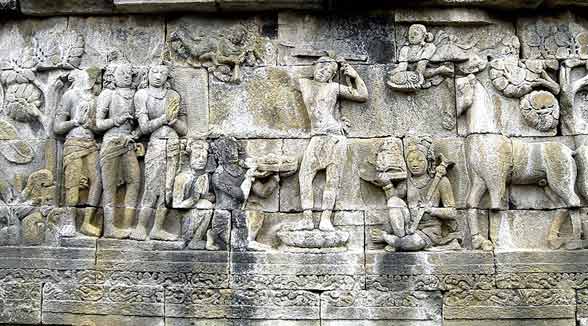
Prince Siddhartha shaves his hair and become an ascetic. Borobudur, 8th century.
Departure and ascetic life
At the age of 29, the popular biography continues, Siddhartha left his palace to meet his subjects. Despite his father’s efforts to hide from him the sick, aged and suffering, Siddhartha was said to have seen an old man. When his charioteer Channa explained to him that all people grew old, the prince went on further trips beyond the palace. On these he encountered a diseased man, a decaying corpse, and an ascetic. These depressed him, and he initially strove to overcome ageing, sickness, and death by living the life of an ascetic.
Accompanied by Channa and aboard his horse Kanthaka, Gautama quit his palace for the life of a mendicant. It’s said that, “the horse’s hooves were muffled by the gods” to prevent guards from knowing of his departure.
Gautama initially went to Rajagaha and began his ascetic life by begging for alms in the street. After King Bimbisara’s men recognised Siddhartha and the king learned of his quest, Bimisara offered Siddhartha the throne. Siddhartha rejected the offer, but promised to visit his kingdom of Magadha first, upon attaining enlightenment.
He left Rajagaha and practised under two hermit teachers. After mastering the teachings of Alara Kalama (Skr. Ārāḍa Kālāma), he was asked by Kalama to succeed him. However, Gautama felt unsatisfied by the practise, and moved on to become a student of Udaka Ramaputta (Skr. Udraka Rāmaputra). With him he achieved high levels of meditative consciousness, and was again asked to succeed his teacher. But, once more, he was not satisfied, and again moved on.
Siddhartha and a group of five companions led by Kaundinya are then said to have set out to take their austerities even further. They tried to find enlightenment through deprivation of worldly goods, including food, practising self-mortification. After nearly starving himself to death by restricting his food intake to around a leaf or nut per day, he collapsed in a river while bathing and almost drowned. Siddhartha began to reconsider his path. Then, he remembered a moment in childhood in which he had been watching his father start the season’s plowing. He attained a concentrated and focused state that was blissful and refreshing, the jhāna.
Enlightenment
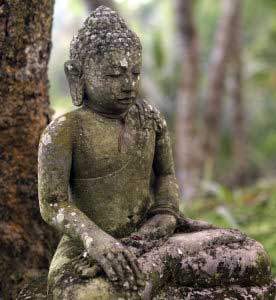
The Buddha sitting in meditation.
According to the early Buddhist texts, after realizing that meditative jhana was the right path to awakening, but that extreme asceticism didn’t work, Gautama discovered what Buddhists call the Middle Way —a path of moderation away from the extremes of self-indulgence and self-mortification. In a famous incident, after becoming starved and weakened, he is said to have accepted milk and rice pudding from a village girl named Sujata. Such was his emaciated appearance that she wrongly believed him to be a spirit that had granted her a wish.
Following this incident, Gautama was famously seated under a pipal tree—now known as the Bodhi tree—in Bodh Gaya, India, when he vowed never to arise until he had found the truth. Kaundinya and four other companions, believing that he had abandoned his search and become undisciplined, left. After a reputed 49 days of meditation, at the age of 35, he is said to have attained Enlightenment. According to some traditions, this occurred in approximately the fifth lunar month, while, according to others, it was in the twelfth month. From that time, Gautama was known to his followers as the Buddha or “Awakened One” (“Buddha” is also sometimes translated as “The Enlightened One”). He is often referred to in Buddhism as Shakyamuni Buddha, or “The Awakened One of the Shakya Clan.”
According to Buddhism, at the time of his awakening he realized complete insight into the cause of suffering, and the steps necessary to eliminate it. These discoveries became known as the “Four Noble Truths”, which are at the heart of Buddhist teaching. Through mastery of these truths, a state of supreme liberation, or Nirvana, is believed to be possible for any being. The Buddha described Nirvāna as the perfect peace of a mind that’s free from ignorance, greed, hatred and other afflictive states, or “defilements” (kilesas). Nirvana is also regarded as the “end of the world”, in that no personal identity or boundaries of the mind remain. In such a state, a being is said to possess the Ten Characteristics, belonging to every Buddha.
According to a story in the Āyācana Sutta (Samyutta Nikaya VI.1) — a scripture found in the Pāli and other canons — immediately after his awakening, the Buddha debated whether or not he should teach the Dharma to others. He was concerned that humans were so overpowered by ignorance, greed and hatred that they could never recognise the path, which is subtle, deep and hard to grasp. However, in the story, Brahmā Sahampati convinced him, arguing that at least some will understand it. The Buddha relented, and agreed to teach.
Formation of the sangha

Buddha and the Sangha
After his awakening, the Buddha met two merchants, named Tapussa and Bhallika, who became his first lay disciples. They were apparently each given hairs from his head, which are now claimed to be enshrined as relics in the Shwe Dagon Temple in Rangoon, Burma. The Buddha intended to visit Asita, and his former teachers, Alara Kalama and Uddaka Ramaputta, to explain his findings, but they had already died.
He then travelled to the Deer Park near Vārāṇasī (Benares) in northern India, where he set in motion what Buddhists call the Wheel of Dharma by delivering his first sermon to the five companions with whom he had sought enlightenment. Together with him, they formed the first saṅgha: the company of Buddhist monks.
All five become arahants, and within the first two months, with the conversion of Yasa and fifty four of his friends, the number of such arahants is said to have grown to 60. The conversion of three brothers named Kassapa followed, with their reputed 200, 300 and 500 disciples, respectively. This swelled the sangha to more than 1,000.
Travels and teaching
For the remaining 45 years of his life, the Buddha is said to have traveled in the Gangetic Plain, in what is now Uttar Pradesh, Bihar and southern Nepal, teaching a diverse range of people: from nobles to outcaste street sweepers, murderers such as Angulimala, and cannibals such as Alavaka. From the outset, Buddhism was equally open to all races and classes, and had no caste structure, as was the rule in Hinduism. Although the Buddha’s language remains unknown, it’s likely that he taught in one or more of a variety of closely related Middle Indo-Aryan dialects, of which Pali may be a standardization.
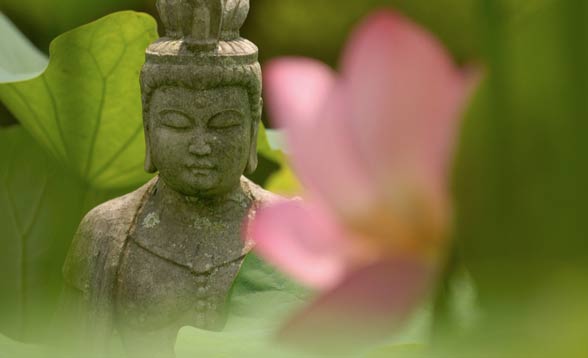
Statue representing the Buddha
The sangha traveled through the subcontinent, expounding the dharma. This continued throughout the year, except during the four months of the vassana rainy season when ascetics of all religions rarely traveled. One reason was that it was more difficult to do so without causing harm to animal life. At this time of year, the sangha would retreat to monasteries, public parks or forests, where people would come to them.
The first vassana was spent at Varanasi when the sangha was formed. After this, the Buddha kept a promise to travel to Rajagaha, capital of Magadha, to visit King Bimbisara. During this visit, Sariputta and Maudgalyayana were converted by Assaji, one of the first five disciples, after which they were to become the Buddha’s two foremost followers. The Buddha spent the next three seasons at Veluvana Bamboo Grove monastery in Rajagaha, capital of Magadha.
Upon hearing of his son’s awakening, Suddhodana sent, over a period, ten delegations to ask him to return to Kapilavastu. On the first nine occasions, the delegates failed to deliver the message, and instead joined the sangha to become arahants. The tenth delegation, led by Kaludayi, a childhood friend of Gautama’s (who also became an arahant), however, delivered the message.
Now two years after his awakening, the Buddha agreed to return, and made a two-month journey by foot to Kapilavastu, teaching the dharma as he went. At his return, the royal palace prepared a midday meal, but the sangha was making an alms round in Kapilavastu. Hearing this, Suddhodana approached his son, the Buddha, saying:
[pull_quote_center]”Ours is the warrior lineage of Mahamassata, and not a single warrior has gone seeking alms”[/pull_quote_center]
The Buddha is said to have replied:
[pull_quote_center]”That is not the custom of your royal lineage. But it is the custom of my Buddha lineage. Several thousands of Buddhas have gone by seeking alms”[/pull_quote_center]
Buddhist texts say that Suddhodana invited the sangha into the palace for the meal, followed by a dharma talk. After this he is said to have become a sotapanna. During the visit, many members of the royal family joined the sangha. The Buddha’s cousins Ananda and Anuruddha became two of his five chief disciples. At the age of seven, his son Rahula also joined, and became one of his ten chief disciples. His half-brother Nanda also joined and became an arahant.
Of the Buddha’s disciples, Sariputta, Maudgalyayana, Mahakasyapa, Ananda and Anuruddha are believed to have been the five closest to him. His ten foremost disciples were reputedly completed by the quintet of Upali, Subhoti, Rahula, Mahakaccana and Punna.
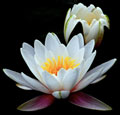
In the fifth vassana, the Buddha was staying at Mahavana near Vesali when he heard news of the impending death of his father. He is said to have gone to Suddhodana and taught the dharma, after which his father became an arahant.
The king’s death and cremation was to inspire the creation of an order of nuns. Buddhist texts record that the Buddha was reluctant to ordain women. His foster mother Maha Pajapati, for example, approached him, asking to join the sangha, but he refused. Maha Pajapati, however, was so intent on the path of awakening that she led a group of royal Sakyan and Koliyan ladies, which followed the sangha on a long journey to Rajagaha. In time, after Ananda championed their cause, the Buddha is said to have reconsidered and, five years after the formation of the sangha, agreed to the ordination of women as nuns. He reasoned that males and females had an equal capacity for awakening. But he gave women additional rules (Vinaya) to follow.
Assassination attempts
According to colorful legends, even during the Buddha’s life the sangha was not free of dissent and discord. For example, Devadatta, a cousin of Gautama who became a monk but not an arahant, more than once tried to kill him.
Initially, Devadatta is alleged to have often tried to undermine the Buddha. In one instance, according to stories, Devadatta even asked the Buddha to stand aside and let him lead the sangha. When this failed, he is accused of having three times tried to kill his teacher. The first attempt is said to have involved him hiring a group of archers to shoot the awakened one. But, upon meeting the Buddha, they laid down their bows and instead became followers. A second attempt is said to have involved Devadatta rolling a boulder down a hill. But this hit another rock and splintered, only grazing the Buddha’s foot. In the third attempt, Devadatta is said to have got an elephant drunk and set it loose. This ruse also failed.
After his lack of success at homicide, Devadatta is said to have tried to create a schism in the sangha, by proposing extra restrictions on the vinaya. When the Buddha again prevailed, Devadatta started a breakaway order. At first, he managed to convert some of the bhikkhus, but Sariputta and Maudgalyayana are said to have expounded the dharma so effectively that they were won back.
Mahaparinirvana
According to the Mahaparinibbana Sutta of the Pali canon, at the age of 80, the Buddha announced that he would soon reach Parinirvana, or the final deathless state, and abandon his earthly body. After this, the Buddha ate his last meal, which he had received as an offering from a blacksmith named Cunda. Falling violently ill, Buddha instructed his attendant Ānanda to convince Cunda that the meal eaten at his place had nothing to do with his passing and that his meal would be a source of the greatest merit as it provided the last meal for a Buddha. Mettanando and von Hinüber argue that the Buddha died of mesenteric infarction, a symptom of old age, rather than food poisoning. The precise contents of the Buddha’s final meal are not clear, due to variant scriptural traditions and ambiguity over the translation of certain significant terms; the Theravada tradition generally believes that the Buddha was offered some kind of pork, while the Mahayana tradition believes that the Buddha consumed some sort of truffle or other mushroom. These may reflect the different traditional views on Buddhist vegetarianism and the precepts for monks and nuns.
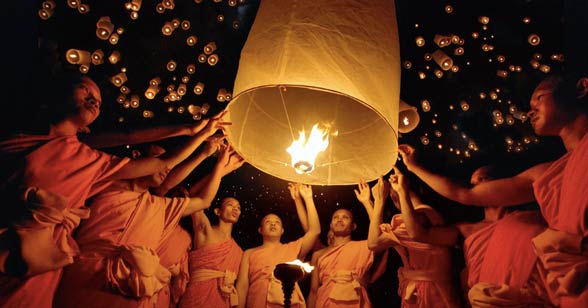
The originally Brahmanical festival was adapted by Buddhists in Thailand as a ceremony to honour the original Buddha, Siddhartha Guatama
Ananda protested the Buddha’s decision to enter Parinirvana in the abandoned jungles of Kuśināra (present-day Kushinagar, India) of the Malla kingdom. Buddha, however, is said to have reminded Ananda how Kushinara was a land once ruled by a righteous wheel-turning king that resounded with joy:
[pull_quote_center]44. Kusavati, Ananda, resounded unceasingly day and night with ten sounds—the trumpeting of elephants, the neighing of horses, the rattling of chariots, the beating of drums and tabours, music and song, cheers, the clapping of hands, and cries of “Eat, drink, and be merry!”[/pull_quote_center]
The Buddha then asked all the attendant Bhikkhus to clarify any doubts or questions they had. They had none. According to Buddhist scriptures, he then finally entered Parinirvana. The Buddha’s final words are reported to have been: “All composite things pass away. Strive for your own liberation with diligence.” His body was cremated and the relics were placed in monuments or stupas, some of which are believed to have survived until the present. For example, The Temple of the Tooth or “Dalada Maligawa” in Sri Lanka is the place where what some believe to be the relic of the right tooth of Buddha is kept at present.
According to the Pāli historical chronicles of Sri Lanka, the Dīpavaṃsa and Mahāvaṃsa, the coronation of Aśoka (Pāli: Asoka) is 218 years after the death of Buddha. According to two textual records in Chinese (十八部論 and 部執異論), the coronation of Aśoka is 116 years after the death of Buddha. Therefore, the time of Buddha’s passing is either 486 BCE according to Theravāda record or 383 BCE according to Mahayana record. However, the actual date traditionally accepted as the date of the Buddha’s death in Theravāda countries is 544 or 543 BCE, because the reign of Aśoka was traditionally reckoned to be about 60 years earlier than current estimates.
At his death, the Buddha is famously believed to have told his disciples to follow no leader. Mahakasyapa was chosen by the sangha to be the chairman of the First Buddhist Council, with the two chief disciples Maudgalyayana and Sariputta having died before the Buddha.
[/vc_column_text][/vc_column][vc_column width=”1/3″][vc_widget_sidebar sidebar_id=”td-default”][/vc_column][/vc_row][vc_row][vc_column][td_block_7 custom_title=”Browse Buddha Quotes” custom_url=”//esotericquotes.com/buddha/” category_id=”3″ sort=”random_posts” limit=”6″ ajax_pagination=”next_prev”][/vc_column][/vc_row]
